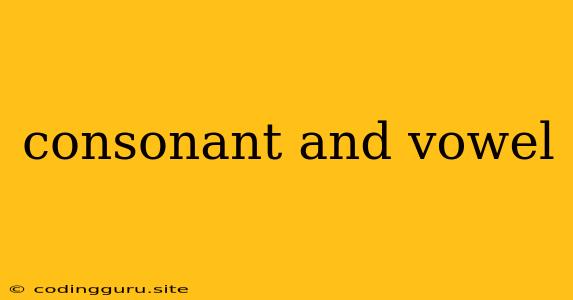Consonant and Vowel: The Building Blocks of Language
Have you ever wondered what makes up the words we speak and write? The answer lies in the fundamental elements of language: consonants and vowels. These seemingly simple sounds form the basis of every spoken and written language, shaping the way we communicate and understand each other.
What are Consonants?
Consonants are sounds produced by partially or completely obstructing the airflow from the lungs. This obstruction can occur at different points in the mouth, using various parts of the tongue, teeth, and lips. The resulting sounds are characterized by their distinct features, such as:
- Place of articulation: Where in the mouth the airflow is obstructed (e.g., lips, teeth, palate).
- Manner of articulation: How the airflow is obstructed (e.g., stopping, friction, or a combination).
- Voicing: Whether the vocal cords vibrate during sound production.
What are Vowels?
Vowels, in contrast, are sounds produced with an unobstructed airflow. They are characterized by the position of the tongue and the shape of the mouth, creating different resonating spaces. Vowels are often described based on their:
- Height: How high or low the tongue is in the mouth.
- Backness: How far forward or backward the tongue is in the mouth.
- Roundness: Whether the lips are rounded or spread.
The Importance of Consonants and Vowels
Consonants and vowels work together to create meaning in language. Consonants provide structure and definition, while vowels create the melodic flow and carry the primary sound of words.
For example, consider the word "cat". The consonants "c" and "t" create the initial and final sounds, giving the word its distinct shape. The vowel "a" adds the core sound and allows for a clear pronunciation.
Consonant and Vowel Combinations
The interplay between consonants and vowels is crucial for creating different sounds and conveying meaning.
Consonants can be combined with other consonants to form consonant clusters, such as "bl" in "blue" or "str" in "street". These clusters add complexity and nuance to sounds.
Vowels can also combine with other vowels to form diphthongs, such as "oi" in "boy" or "ow" in "cow". These vowel combinations create a gliding sound, adding further richness to language.
Learning Consonants and Vowels
Understanding consonants and vowels is essential for both speaking and writing.
- For speakers: Identifying and understanding the different sounds of consonants and vowels is vital for clear pronunciation and communication.
- For learners: Mastering the phonetic representation of consonants and vowels is crucial for accurately reading and writing.
Examples of Consonants and Vowels
Here are some examples of consonants and vowels in the English language:
Consonants:
- Stops: /p/, /b/, /t/, /d/, /k/, /g/
- Fricatives: /f/, /v/, /θ/, /ð/, /s/, /z/, /ʃ/, /ʒ/, /h/
- Affricates: /tʃ/, /dʒ/
- Nasals: /m/, /n/, /ŋ/
- Liquids: /l/, /r/
- Glides: /w/, /j/
Vowels:
- /i/ (as in "see")
- /ɪ/ (as in "sit")
- /e/ (as in "say")
- /ɛ/ (as in "set")
- /æ/ (as in "cat")
- /ʌ/ (as in "cup")
- /ɑ/ (as in "cot")
- /ɔ/ (as in "caught")
- /u/ (as in "boot")
- /ʊ/ (as in "put")
Conclusion
Consonants and vowels are the fundamental building blocks of language. They work together to create the sounds and words that we use to communicate, share ideas, and express ourselves. By understanding the distinctions between consonants and vowels, we can appreciate the complexity and beauty of language and gain a deeper insight into how we create and understand meaning.
